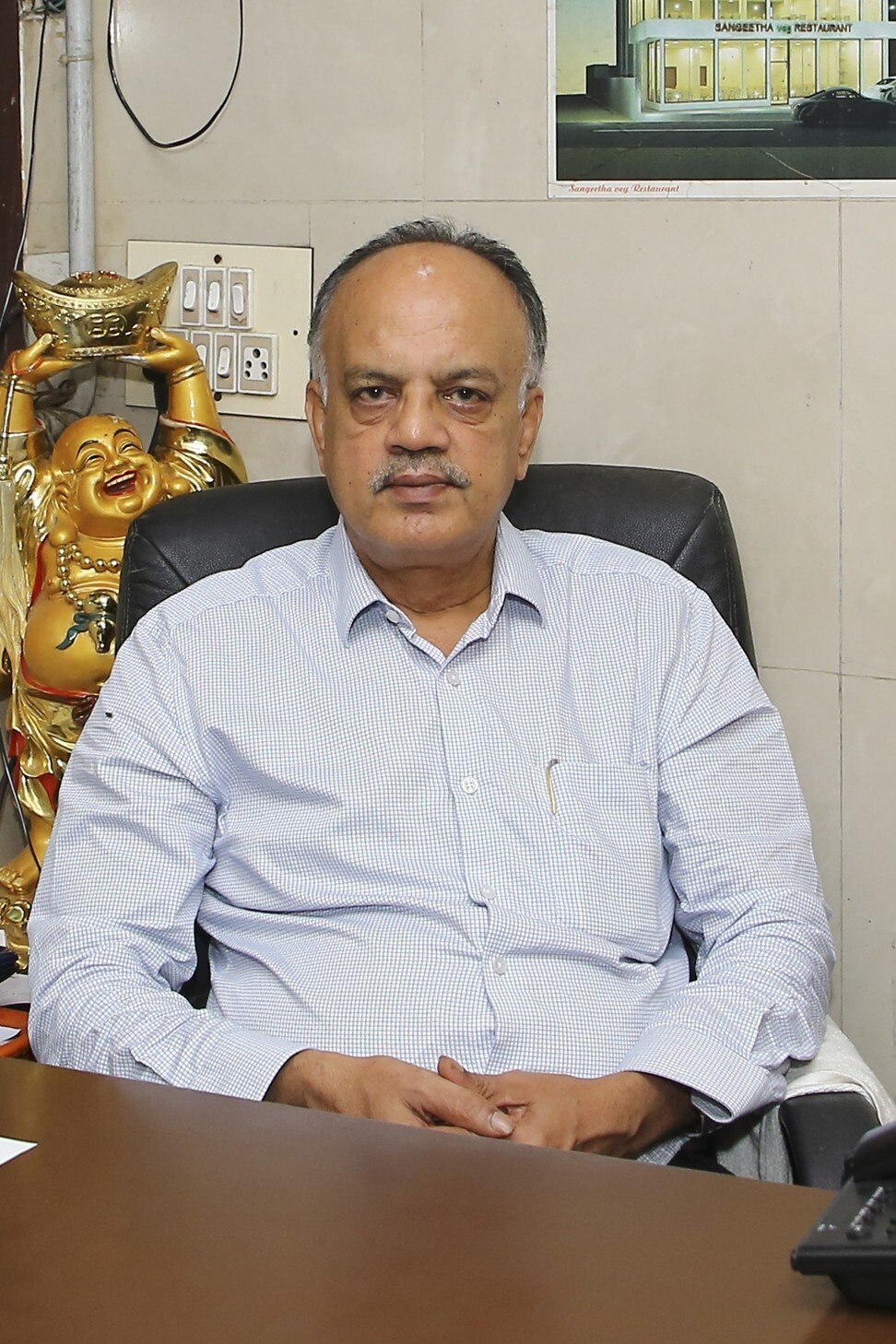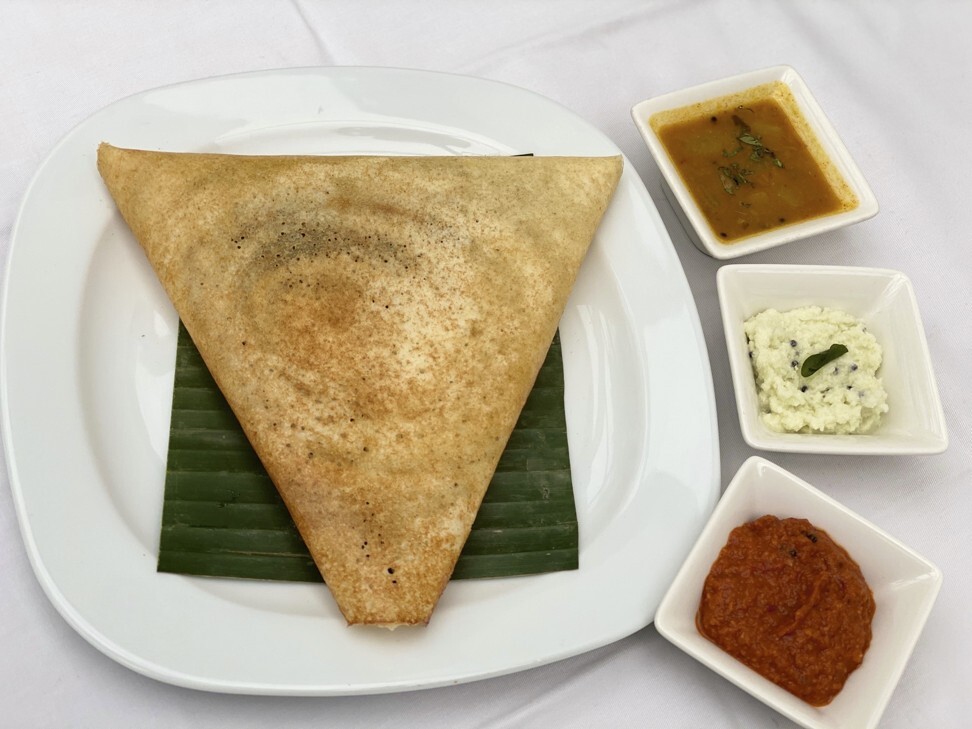
Dosa: Indian filled pancake makes a complete and healthy meal at any time of the day
- Served in infinite varieties and at all times of day, the fluffy, crispy pancake made from fermented batter is usually eaten for breakfast in South India
- Rich in carbohydrates and protein, sugar-free and gluten-free, a dosa is a complete and healthy meal. No wonder it has spread around the world
Step aside, you CEOs – Sunder Pichai at Alphabet, Microsoft’s Satya Nadella and Indra Nooyi – formerly Pepsi’s: southern India’s best-known export is a humble food item eaten daily by millions, the dosa.
“The dosa is an integral part of my home. I grew up watching my mother cook them for breakfast every day,” recalls Mallika Ramarao, 50, a social worker from Chennai who learned how to make dosas from her mother.
“She would pour the batter on to the hot tava [pan] and spread it carefully using the bottom of a small steel bowl. Next, she would add a little ghee (clarified butter), not too much, so that the batter would set firmly instead of sliding around the pan. The dosa would turn golden and crisp on the bottom while the top stayed nicely white and slightly spongy.

“The exterior of the dosa should be crisp, and when it cools it should contrast with the soft, warm stuffing inside.”
“An indispensable part of making the dosa is fermenting the batter overnight so it acquires the right texture and a slightly sour flavour,” Ramarao adds.
Inexpensive and easy to make, dosas are the preferred breakfast option in southern India, but can be eaten at any time of the day. Rich in carbohydrates and protein, sugar-free and gluten-free, a dosa is a complete and healthy meal.
Once very much a regional delicacy, today they can be found everywhere in India – at roadside stalls, quick service chains – and even in fine dining restaurants around the world.
“A dosa invokes the senses with its flavour, its crispy texture and its buttery taste,” says Sriram Aylur, executive chef at Quilon, a one-Michelin-star restaurant in London. “The presentation of the dish is as impressive as its contents. Placed on a large serving plate, it looks like a giant crepe curled around its fragrant spicy filling accompanied by an array of colourful chutneys.”
Susan Jung applauds the dosa, aka the Indian crepe
Aylur believes the dosa is so popular because it can be adapted to different cultures and regional tastes.
“You can use as little or as much oil, and the spice levels of the stuffing and the accompaniments can be adjusted as you like,” he says.
“For the chef, the dosa is very versatile as it offers endless options to be creative with different ingredients and fillings.” Aylur has served dosas stuffed with ingredients such as crab, eggs, paneer (cheese) and minced chicken.

Dosas have been enjoyed in India for centuries. In his book The Story of Our Food, historian K.T. Achaya says there are references to dosas in Tamil literature dating back to the first century AD.
A recipe for dosa, known as dosaka, is found in the Manasollasa, an early 12th century work written in Sanskrit by King Someshvara III who ruled over present-day Karnataka, a state in southern India.
“It is fascinating that south Indians had the knowledge of fermentation 1,000 years ago,” says Padmanabha Rajagopal, 64, a partner in Sangeetha, a 27-year-old restaurant chain with 30 branches in Chennai and more than 15 branches outside India, including one in Hong Kong.

Credit for the spread of the dosa goes to restaurateurs from Udipi in Karnataka, a town famous for its temples, innovative food culture and the entrepreneurial spirit of its residents.
Udipi restaurants first arrived in Bombay (now Mumbai) in western India in the 1930s and popularised the dosa there, creating new versions – as they do to this day.

The technique of adding a spicy filling, or “masala”, is believed to have been born at the behest of the maharaja of Mysore, a city in Karnataka. After a lavish celebration at the palace, the maharaja is believed to have asked his chefs to come up with a way to use the leftover food. The chefs stuffed the plain dosa with potato and spices and produced the first masala dosa.
The Mysore masala dosa is particularly sought after in India. “A thick red, chutney made of garlic and red chillies is spread on the dosa, which is then topped with a filling of potato masala which consists of potatoes cooked with onions, mustard seeds, green chillies, ginger and turmeric,” says chef Thomas Gomes of Jashan, an Indian restaurant in Hong Kong.
“The dosa is cooked on a thick seasoned pan and has a thin crust with a golden hue,” he adds. “It is crispy, brown and red on the outside and spongy and soft on the inside. Masala dosas are one of the most popular dishes in our restaurant.”
The presentation of the dish is as impressive as its contents. Placed on a large serving plate, it looks like a giant crepe curled around its fragrant spicy filling accompanied by an array of colourful chutneys
The versatility of the dosa is evident in its endless varieties. The better-known ones are the plain paper dosa (papery crisp and light), the rava dosa (made from semolina and rice flour) and the neer dosa (made with a watery rice-only batter).
In the city of Madurai in Tamil Nadu, dosas take a divine turn. On the city’s outskirts stands the Azhagar Kovil temple, dedicated to the Hindu deity Vishnu. As famous as the temple is the Azhagar Kovil dosa, served to devotees and tourists who flock to the shrine to seek the deity’s blessing.
Unlike other varieties, these dosas are deep-fried. The batter is not fermented and it is spiced with pepper, cumin and ginger powder to enhance the flavour.

Pai Dosa, a popular cafe in the city of Kochi in Kerala, is known for adding innovative ingredients to the dosa. “We like to experiment and offer more than 180 varieties of dosas,” says Ganesh Pai, 31, whose father and uncles started the restaurant in 1987.
One of their most popular varieties is the dundu dosa. “[It] has vegetables, eggs, cashew, cheese and even chocolate, and is a complete three-course meal by itself,” Pai says. “I had a friend try it out before we offered it on the menu and he absolutely loved it. Now it is one of our specials.”
Some of Pai Dosa’s other popular offerings are the salt and pepper dosa (which includes onions, quail eggs, coconut chutney and potato masala), cashew masala dosa (made with liberal amounts of cashew nuts), leaf dosa (a vegetable known as drumstick in India and moringa elsewhere is added to the batter, giving it a green colour), and a dosa named for the city of Kanchipuram in Tamil Nadu (beetroot is mixed in the batter, which gives it a reddish shade).
Each southern Indian state has its favourite dosa.
“I grew up eating masala dosa and benne dosa,” says Ramarao, the social worker from Chennai. “Benne dosa [benne means butter] is prepared like a regular dosa, with heaps of butter added, and served with coconut chutney. It is a speciality of Karnataka. Pesarattu, a popular dosa from Andhra Pradesh, is one of my favourites now. It is made of green gram with a stuffing of semolina and is served with ginger chutney.”
Then there is the truly cool dosa called challa attu (challa means cool). Made of rice batter and buttermilk, it is in demand in the summer months. These dosas are soft and fluffy, slightly tangy, easy to make and use less oil.
Small or large, thick or thin, sweet or sour, cool or hot, dosas are southern India’s gift to the world of gastronomy.

